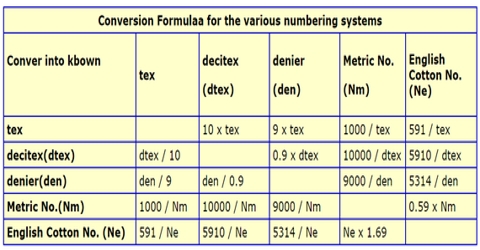Main focus of this Assignment is given about the yarn count, System of Count Numbering, Analytical System, Quadrant Balance, Beesley Balance, Stubb Yarn Balance, Conversion of Yarn Count and several ways how to convert yarn count measurement with examples.
1. COUNT
The count is nothing but a numerical expression which defines the thinness or thickness of a yarn. It means that, the yarn count refers how much a yarn is fine or course. We also can say that the yarn count number indicates the length of yarn in relation to the weight.
But according to the Textile Institute, they define yarn count as “A number indicating the mass per unit length or length per unit mass of a yarn”.
Yarn count is also known as yarn number or linear density.
2. SYSTEM OF COUNT NUMBERING
Different sorts of system or units are used to measuring the yarn count or yarn number which mostly depends on the material used for preparing the yarn and the area where it was manufactured.
All the system of count measuring can be grouped as following categories;
- Analytical System &
- Instrumental System.
Analytical System
Actually this process is consisting with some other systems based on several calculations and this is why it is called Analytical system. The systems are including;
- Direct System &
- Indirect System
Direct System
In this system, the count of the yarn is the number of units of weight per unit length of yarn. This system is mostly used for silk, jute etc.
We can work in this system by following categories;
- Tex
- Denier &
- Jute Count
Tex
It can be defined as the weight present in 1000 meter of yarn in grams where length of yarn is fixed. It means that, for example, if there is a 1000 meter of yarn and have a weight of 20gm then the yarn count will be 20tex. Because tex refers the weight in gram of unit length.
Here is the equation for determining the yarn count in Tex;
Tex = Weight in grams/Length in 1000 meter,
or
Tex = Sample weight in gm * Unit length (1000m)/Sample length in meter
An extra qualification of Tex system we know that it is known as the universal process of yarn count which is introduce by International Standard Organization (ISO) with several textile scientists, technologists and manufacturers.
- Denier
It is defined as the weight of yarn thread in grams presented in per 9000 meter length of that yarn. It is just like about Tex system only has to change the unit length from 1000m to 9000m and then the equation of denier becomes as;
Den = Sample weight in gm * Unit length (9000m)/Sample length in meter
As an example we can say about 454 meter of yarn containing 5 gram of weight then the count in Den will be
Den = 6 * 9000/454 = 118.9 den
Jute Count
The weight of yarn of 1 lb present in 14400 yds length of yarn is known as jute count or pounds per spindle.
Indirect System
In this system the count is the number of unites of length per unit weight of yarn. In this case yarn fineness is inverse to the yarn count, it means that the more the yarn count, the finer the yarn. By this system we can measure the count number of cotton, woolen, worsted linen etc.
This is also having some sub-system as following;
- Cotton Count
- Metric Count &
- Worsted count.
Cotton Count
Actually by the term cotton count can be defined as the number of hanks of 840 yds presented in 1 lb weight of yarn. This is also known as British or English count. It is denoted by Ne
The equation of cotton count measurement is as following;
Count, Ne = Length in hanks of 840 yds/Weight in lbs, or
Ne = Sample length in yds * unit weight/Sample weight in lbs * unit length
Now for an example, if we consider a yarn sample of 2000 yds with a weight of 0.08 lb then the cotton count will be
Count, Ne = 2000 * 1/0.08 * 840 = 29.7 Ne
Metric Count
Metric count is express 1000 gm or 1 kg weight of yarn can contains how many numbers of hanks of 1000 meter. It is denoted by Nm.
The formula of measuring metric count is;
Metric Count, Nm = Sample length in meter * unit weight/Sample weight in kg * unit length
For example, if we consider a yarn of 2000m having the weight of 450g. So the count in metric system will be
Metric Count, Nm = 2000 * 1/0.45 * 1000 = 4.4 Nm
Worsted Count
It is the number of hanks of 560 yds presented in 1 lb weight of yarn is known as worsted count which is widely used for yarn composed by wool.
Instrumental System
By this process count of yarn is measured by using different sorts of instrument where any kind of calculation is not needed and we can get directly the yarn count. The machines which are mostly used of count measurement are given bellow;
- Quadrant Balance
- Beesley Balance
- Stubb Yarn Balance
Quadrant Balance
In textile testing lab we have to measure yarn count of different length. Where some are long but some are short. All the machine or balance can’t measure the count of short lengths yarn. To overcome this obstacle a balance named Quadrant was made to measure the count of yarn containing the length less than 120 yards and this is a direct reading yarn count balance.
Machine Parts
This balance is consisting with the following parts;
- Quadrant scale Yarn sample
- Piller Sample hook
- Pointer Leveling screw
- Counter weight
Machine Description
This balance have a quadrant scale which is divided into other three scale including the top one scale is used to find the weight per squire yard of sample the middle one find the count of yarn length 8 yards and finally the third one is used to find the count of yarn of length 40 yards.
A pillar is used to hold all the parts and the quadrant scale is attached with the pillar by a pivote.
Another pivote hold a pointer which mark the reading on the scale.
The same pivote holds a beam which has a sample hook at one end and a counter weight in another.
At the base of the balance there is a leveling screw by which we can leveled the instrument.
Finally when we put the sample in the sample hook adjusting with the counter weight the pointer show the count of yarn directly on the scale.
One important thing is that we have to calibrate the balance before we used it. The pointer of this machine will reads 40s on 40 yards scale when it is leveled but if not we have to calibrate again properly.
Beesley Balance
Beesley balance is widely used for measuring the yarn count removed from a fabric sample. This is work on the principal of fixed length and fixed weight system.
Machine Parts
The Beesley balance is consisting by the following parts;
- Base Datum line
- Pillar Pivot
- Beam Rider
- Pointer Sample hook
- Notch Leveling screw
- Template
Machine Description
This balance is stands on a base where a leveling screw is present which is used to level the instrument and if it is leveled the pointer, at one end of the beam, will equal to the datum line.
The beam is attached with the pillar by a pivot and there is a hook at the opposite site of the pointer at the beam which holds the sample.
There is also a notch in the beam which holds the rider according to the sample, if the sample is warp yarn, the rider will be full weight & if the sample is weft then there will be the half rider 68mg of weight.
Finally, after setting the machine we will count the number of yarn that make the pointer leveled to the datum line and the number of yarn will be the yarn count in Ne.
Stubb Yarn Balance
Stubb yarn balance is also worked on the basis of fixed length & fixed weight as like a Beesley balance and it is used to find the count of fabric sample. Here the number of fixed weight yarn gives the count of yarn.
Machine Description
This Stubb yarn balance consists of a pillar, at the top of which. A beam is pivoted on a knife edge. A sample hook is attached at one end of the beam and a weight hook at the other end. A template is used to cut the yarn in fixed length. Different weight hook is used for different yarn.
After selecting the weight hook the yarn to be measured is suspend at the sample hook until the balance becomes at balance position. Thus the number of thread used to balance the beam gives the count of the yarn.
This is a very simple instrument and there is no mechanism which goes out of order and don’t need any electrical or other extra energy.
CONVERSION OF COUNT
We can convert the value of count from one to other system by followings only some formulas. So for the conversion we may divide them in four groups as following;
- Conversion from direct to direct
- Conversion from indirect to indirect
- Conversion from direct to indirect &
- Conversion from indirect to direct
There are two formulas to convert the yarn count as given billow
- Unknown count = Multiplying converting factor * Given count
- Unknown count = Constant / Given count
Here the first one is used for first two group of conversion (direct to direct & indirect to indirect) and second one is for last two group including direct to indirect & indirect to direct.
The table of converting factor and the count constant is given billow;
Direct to Direct
| Known yarn count in | Multiplying converting factor for unknown count | |
| Tex | Denier | |
| Tex | ——- | 9 |
| Denier | 0.1111 | —— |
| Jute count | 34.45 | 310 |
Example;Denier of unknown count = Tex (known count) * 9
Tex of unknown count = 0.1111 * Den or Jute count
Indirect to Indirect
| Known yarn count in | Multiplying converting factor for unknown count | |
| Metric (Nm) | Worsted | |
| Cotton (Ne) | 17 | 1.5 |
Example; Metric Count = 17 * known cotton or worsted count
Worsted Count = 1.5 * known cotton or Metric count
Indirect to Indirect & Direct to Direct
| Known yarn count in | Constant | |
| Tex | Denier | |
| Cotton | 590.5 | 5315 |
| Metric | 1000 | 9000 |
Example; Metric = 9000/Known Den count
Denier = 5315/Known Ne
CONCLUSION
An increasingly important branch of textile technology is the geometry of fabric structure, which is mostly depends upon the yarn structure. As a result of yarn structure the appearance, hands feel and some other general behaviour can be changed. Here the term yarn structure indicates the fineness or coarseness of yarn. So it is necessary to develop our knowledge about yarn count before starting work not only for yarn but in the textile world.
















